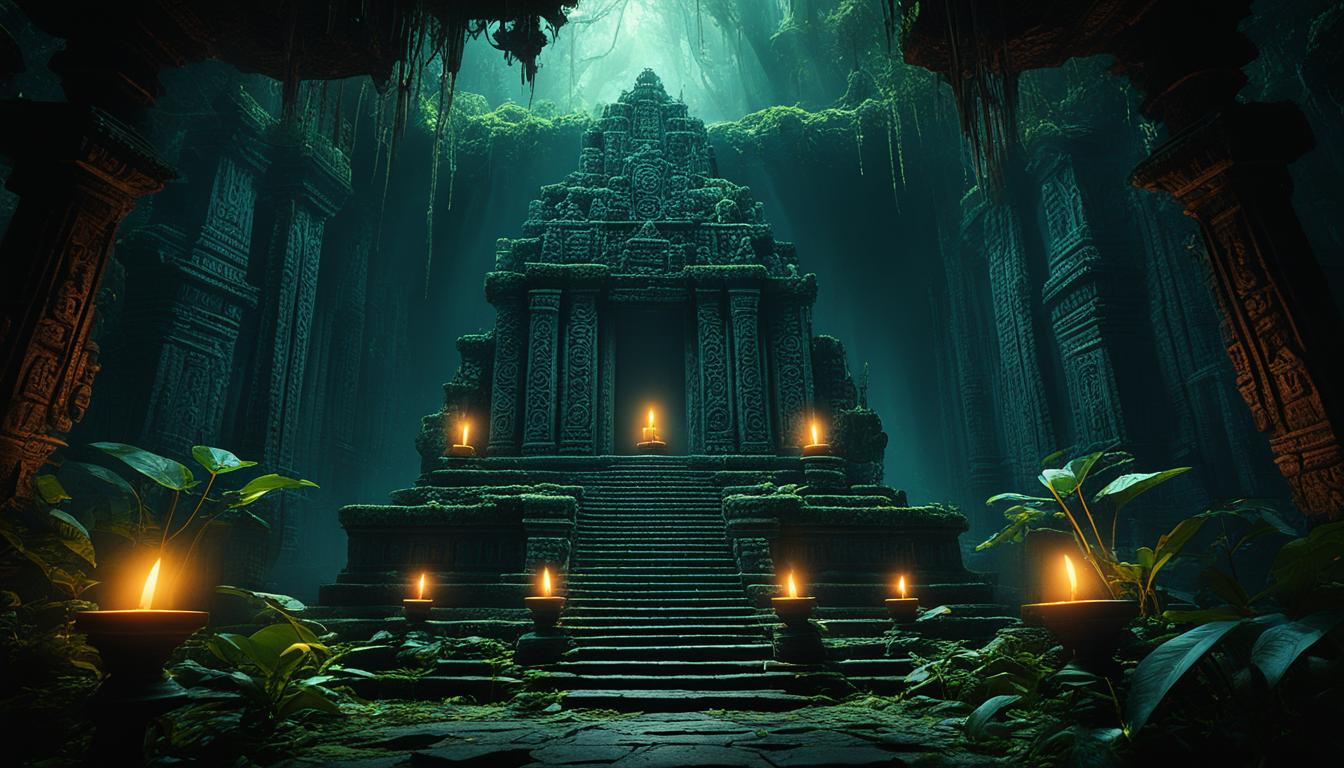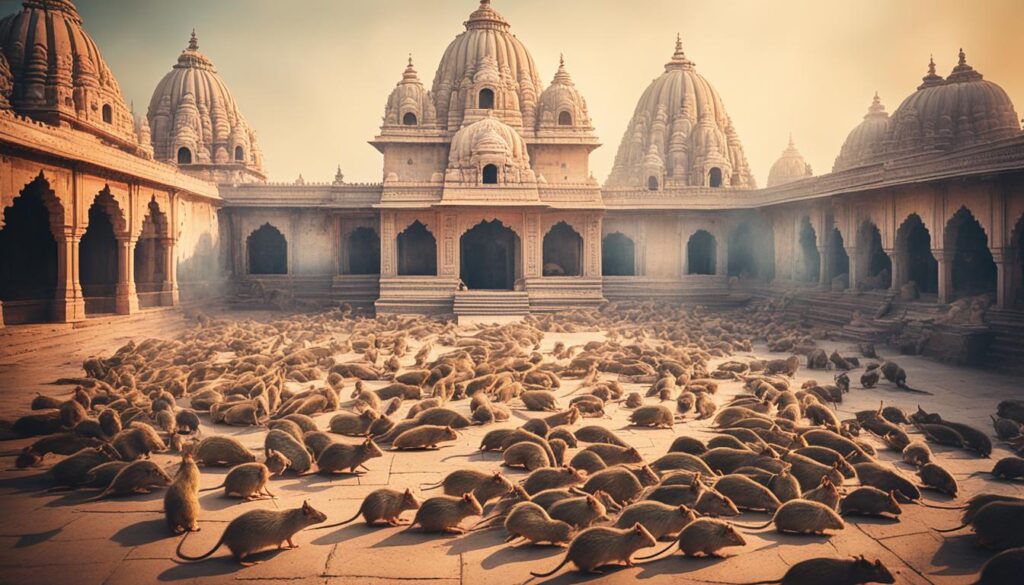
Exploring Mysterious Places in India: A Guide
Did you know that India is home to countless mysterious places shrouded in enigma and steeped in intrigue? From unexplained phenomena to enigmatic landmarks, the country offers a treasure trove of secrets waiting to be unraveled. Join us on a thrilling journey as we embark on an expedition to some of the most fascinating mysterious places in India.
Prepare to be amazed as we delve into the hanging pillar of Lepakshi and the village of Kodinhi, where twins seem to be more than just a coincidence. Discover the rat-infested Karni Mata Temple in Rajasthan and the gravity-defying Magnetic Hill in Leh. Explore the doorless village of Shani Shingnapur in Maharashtra and venture to the Kongka La Pass, a gateway to unearthly encounters. Get ready to unlock the secrets of these unexplained wonders as we delve into the mystique of India’s mysterious places!
Lepakshi, Andhra Pradesh: The Suspended Or Hanging Pillar
Lepakshi, a small village in Andhra Pradesh, boasts an architectural wonder that has captivated visitors for centuries. Known as the Hanging Pillar, this extraordinary structure defies the laws of gravity, appearing to hang from the ceiling without any visible support.
Located within the Veerabhadra Temple, the Hanging Pillar is a testament to the ingenuity and craftsmanship of ancient Indian architects. Its mystifying design has baffled experts and intrigued tourists from around the world.
As visitors step into the temple, their gaze is immediately drawn to the awe-inspiring Hanging Pillar. It stands as a testament to the advanced engineering techniques employed by ancient builders, showcasing their unparalleled skill and artistry.
Visitors to Lepakshi often partake in a tradition associated with the Hanging Pillar. Many pass objects beneath it in the hopes of receiving good fortune and blessings from the divine.
“The Hanging Pillar in Lepakshi is a true architectural marvel. Its gravitational defiance leaves spectators in awe and stimulates their curiosity. This enigmatic structure continues to be a symbol of India’s rich cultural heritage.”
While the exact mechanism behind the Hanging Pillar remains a mystery, several theories have emerged. Some believe that advanced engineering techniques were employed to create a hidden support system within the pillar. Others suggest that the ancient builders possessed sacred knowledge and construction techniques that have been lost to time.
The Hanging Pillar of Lepakshi serves as a reminder of humanity’s artistic and technological prowess. Its intricate design and unique construction make it a must-visit for architecture enthusiasts, historians, and those seeking an encounter with an extraordinary ancient wonder.
Key Information About Lepakshi’s Hanging Pillar
| Location | Architectural Wonder | Unique Feature |
|---|---|---|
| Lepakshi, Andhra Pradesh | The Hanging Pillar | Appears to hang from the ceiling without any visible support |
Kodinhi, Kerala: The Land of Twins
The village of Kodinhi in Kerala has gained fame as the “Land of Twins” due to its unusually high number of twin births. With over 200 pairs of twins in a small geographical area, Kodinhi has perplexed researchers and scientists. The exact reason for this phenomenon is still unknown, but some theories suggest that the consumption of locally grown produce or the presence of chemicals in the water may play a role. Visitors to Kodinhi can witness this unique and mysterious phenomenon firsthand.

| Key Points | Explanation |
|---|---|
| Unusual Phenomenon | Kodinhi is renowned for its exceptionally high number of twin births, making it a subject of intrigue and investigation. |
| Village of Twins | Kodinhi boasts over 200 pairs of twins, leading to its reputation as the “Land of Twins.” |
| Possible Causes | The exact reason for the high concentration of twin births in Kodinhi remains unknown. However, hypotheses suggest that environmental factors like local vegetation or water composition could contribute to this phenomenon. |
| Unique Experience | Visitors can observe the remarkable occurrence of twins in Kodinhi, providing an opportunity to witness an unusual natural phenomenon. |
Rajasthan: The Rat-Infested Temple
The Karni Mata Temple, also known as the “Temple of Rats,” is located in the town of Deshnoke in Rajasthan. Home to thousands of rats, the temple is considered sacred and worshipped by devotees. The rats are believed to be the reincarnations of Karni Mata’s devotees, and their presence is seen as divine.
Visitors to the temple can observe rats freely roaming the premises, and spotting a white rat is considered to bring good fortune. The origin of the veneration of rats in the Karni Mata Temple can be traced back to local legends and folklore surrounding the revered mystic and spiritual leader, Karni Mata.
| Interesting Facts about the Karni Mata Temple | |
|---|---|
| The temple is home to over 20,000 rats. |  |
| Rats freely roam the temple and are considered sacred. | |
| Spotting a white rat is believed to bring good luck. | |
| The rats are believed to be the reincarnations of Karni Mata’s devotees. |
In the Karni Mata Temple, the rats are not seen as pests but rather as divine creatures. They are treated with reverence and provided with food, shelter, and protection. The temple offers a unique and unusual experience, immersing visitors in the mystical and spiritual traditions of Rajasthan.
Leh, Ladakh: The Magnetic Hill
Nestled in the mesmerizing landscapes of Leh in Ladakh, the Magnetic Hill is a natural wonder that challenges our understanding of gravity. Vehicles parked on the hill with their engines turned off appear to roll uphill, seemingly defying the force of gravity. This gravity-defying phenomenon has fascinated locals and tourists alike, and although it may appear to be the result of magnetism, scientific investigations have revealed that it is, in fact, an optical illusion. The road’s construction and the surrounding slopes create the illusion of an uphill slope, while the road itself is, in reality, flat.
Shani Shingnapur, Maharashtra: The Village Without Doors
In the small village of Shani Shingnapur in Maharashtra, residents have chosen to live in houses without doors. This unique practice is rooted in their deep faith and belief in the protective power of Lord Shani, the deity associated with justice and adversity.
The village is known for its zero crime rate, and residents trust that their homes are safe under the watchful gaze of Lord Shani. The absence of doors symbolizes their unwavering faith and belief in divine protection.
Kongka La Pass, Ladakh: A Gateway to E.T. Encounters
The Kongka La Pass, nestled in the mesmerizing landscapes of Ladakh near the border between India and China, has emerged as a legendary destination associated with extraterrestrial encounters and UFO sightings. This remote mountain pass has witnessed numerous reports and accounts from eyewitnesses who claim to have spotted unidentified flying objects in the region, igniting speculation about the existence of advanced extraterrestrial civilizations.
The strategic location of Kongka La Pass, combined with the alleged UFO sightings, has captured the imagination of conspiracy theorists and UFO enthusiasts, who are drawn to this mystical place in search of answers. The pass’s rugged terrain and secluded surroundings only add to its allure, making it an ideal setting for those hoping to catch a glimpse of otherworldly phenomena.
While skeptics attribute the sightings to natural phenomena or misidentifications, the stories and experiences shared by witnesses continue to fuel curiosity and debate. The air of mystery surrounding Kongka La Pass makes it a must-visit destination for those intrigued by the unknown, providing an opportunity to explore the intersection of our world and the outer realms.
Source Links
- https://traveltriangle.com/blog/mysterious-places-in-india/
- https://www.sotc.in/blog/indian-holidays/mysterious-places-in-india-to-visit
- https://www.treebo.com/blog/mysterious-places-in-india/

Leave a Reply